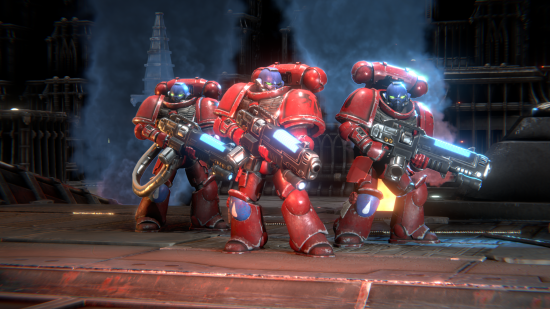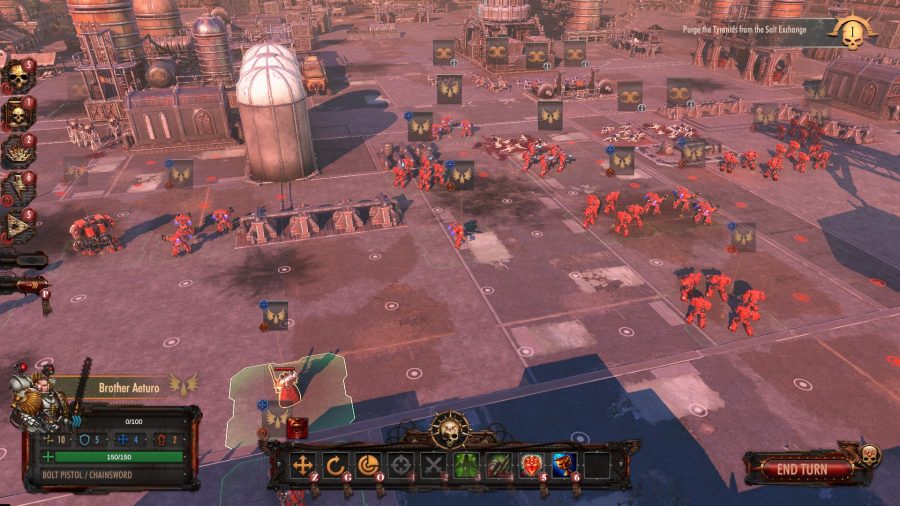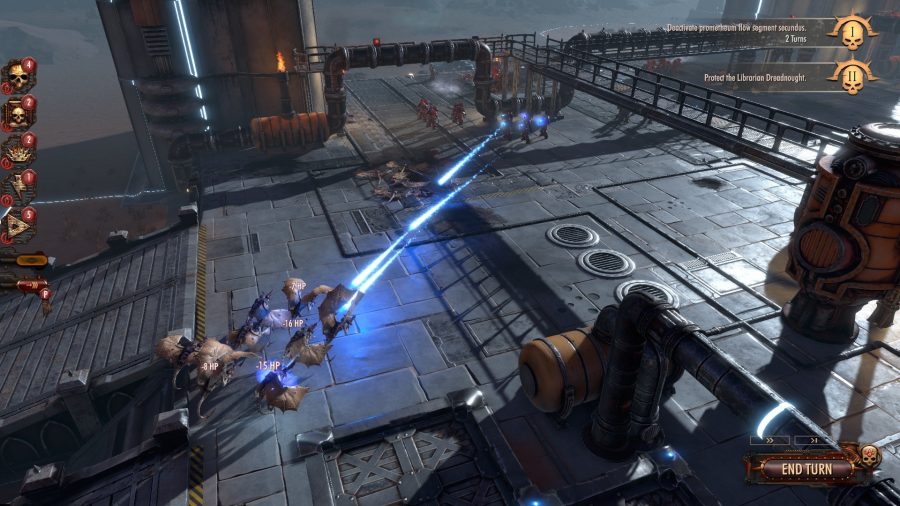Our Verdict
A solid skirmishing system and varied level design can't keep Battlesector afloat under its tendency towards tedious routine.
Playing Warhammer 40,000: Battlesector is hard work. Not because it’s challenging; quite the opposite. Its streamlined turn-based strategy does well to ease you in, and its quick-to-action linear campaign has you skirmishing with just the right level of tactical nous. Rather, playing Battlesector is hard work because squeezing saps of enjoyment from a game that does its utmost to stall, stale, and saturate itself with prolonged tedium is guaranteed to leave a bad taste in the mouth.
The latest release from Black Lab Games, developer of the much-praised Battlestar Galactica Deadlock, Battlesector is fairly standard digital wargaming fare. You’ll take command of a battalion of Blood Angel Space Marines, shifting them about a gridded map, seizing objectives, and slinging lead at alien Tyranid forces, before the AI jumps in to have its go. Each unit is assigned a number of ‘action points’ per turn with which to perform attacks, and powerful hero units can be upgraded with additional abilities between missions.
You’ll be looking to optimise every unit. Choose your force at the beginning of each mission, and make the most out of their limited actions before the Tyranid swarm swells into gargantuan size. Cover advantages come into focus, and you’re encouraged to use terrain to bottleneck enemies, or pincer their movements. New units are unlocked frequently between missions, giving you plenty of toys that offer offensive specialities.
There’s nothing astoundingly new here, but the core action is pleasant enough. Missions usually have you chasing a specific objective on the other side of the map, or destroying a specified number of targets, but level variety keeps things fresh. Sometimes you’ll be moving across vast open wastelands, staggering your forces so as not to break their front battleline. While at other times you’ll be progressing through narrow, branching trenches, and running away at the sight of whatever nasty looking xenomorphic beasty is lurking around the corner.
But turn-to-turn gameplay takes a similar stride on each level. Move your infantry forward, make a few attacks, and then bring in your hero units for the big damage. Sometimes you’ll have to defend an ambushed position, but the rhythm of gameplay never changes, and the basic move-attack formula never lets up. On standard difficulty, rarely, if ever, did I feel the need to experiment with my heroes’ buffing abilities, or reach outside of their basic attacks. Besides a couple of high-level offensive unlocks, I found myself using the same few essential actions on every turn, and the slew of passive buffs became irrelevant.
More disappointingly, the game’s standout ‘momentum system’ bears little relevance to baseline gameplay. Your marines earn momentum points for attacking enemies and plunging headfirst into the fray, which may be spent on upgrading their abilities or performing an extra action that turn. But momentum generates so gradually, and its rewards are so feeble, that it warranted little of my attention. It was often quicker to forget the metric, focus on standard attacks, and be pleasantly surprised when the momentum bar happened to reach the top.
This lack of variety only worsens with each mission’s cumbersome post-objective phase. After completing your main goal, you’re tasked with eliminating the remaining Tyranid forces. A minor chore at first, it becomes an exasperating slog on later, larger missions that will have you sweeping a map that you’ve already explored, on a level you’ve already completed.
In one mission, I was tasked with escorting a Dreadnought Librarian to a relay beacon and protecting him from incoming Tyranids across four turns. After a tough fight, my scattered Marines were already bloodied, and the defeat of the final Tyrannofex seemed like a fitting climax to the mission.
Except it wasn’t the end, and the climax quickly proved premature. I had to clear out the remaining 15 Tyranid units (roughly half the number that I’d already spent 20 minutes slaying) that were strewn across the map. There were no more tactical manoeuvres to plan, and no real challenge. Your final test in every mission is a grunt-hunting slog.
Open tombs: Read our Battlesector: Necrons DLC review
It’s doubly a shame because Battlesector does a respectable job of introducing set pieces into its static, turn-based gameplay. With no cutscenes and limited mid-mission dialogue, the presence of a new Tyranid unit lurking on the edge of my fog of war was still able to inspire some trepidation within me.
Levels, too, allow you to visualise your Marine’s doomed last stand against the swarm, or their valiant defeat in an ambush. Terrain is set up in such a way as to encourage moments of cinematic skirmishing that lend a dynamism to the game.
Battlesector leans hard into its theme, and has all the trappings of its Warhammer 40k source material. Hulking Space Marines tear through alien swarms in exultant displays of bloody violence, big guns are met with even bigger beasties, and every human in sight spouts their allegiance to the Emperor of Mankind in faux-aristocratic syntax. It’s a game in love with the 41st millennium, and a visually gorgeous digital representation of your favourite Space Marine minis.
But, like its central gameplay, even this thematic commitment soon wears thin. Voice barks (the short lines of dialogue spoken by your units after they perform an action) are delivered in suitable theatrics, but hearing your soldiers declare their love for Sanguinius or expressing that they are ‘under fire’ for the umpteenth time becomes repetitive, fast.
Stranger still is the endless monologuing that sits in alienation from Battlesector’s central gameplay. Before each mission, protagonist Sergeant Carleon will endlessly soliloquise in a series of voiced text boxes about the new Primaris Space Marines, as he wrangles with their place in the Blood Angels chapter, and struggles to accept them as fellow soldiers.
The theme of companionship is refreshing in a universe that’s first and foremost about intergalactic genocide. But it’s placed in complete separation from the game’s main action and narrative, which follows the routing of the Tryanid force following the desecration of the Blood Angels’ home planet. The differences between the Primaris and regular marines have no implication on my command, and Carleon’s theatrical rabbiting serves as more of a confused diversion than an engaging aside.
This tiresome story-building also distracts from the more exciting characters of the game, including a cranky Techpriest who shows up halfway through and possesses more character than every one of the bald-headed, cold-hearted, vanilla-flavoured heroes that speak most of the dialogue. I wanted to see more of that guy.
Warhammer 40,000: Battlesector is a fine game at its core, held down by tedium that overshadows the primal enjoyment of squishing rabid alien beasts with your favourite Space Marine models. Its commitment to its source material does nothing to alleviate the slog, and will more likely have you cursing the Emperor’s name than singing his praises. A missed shot.




